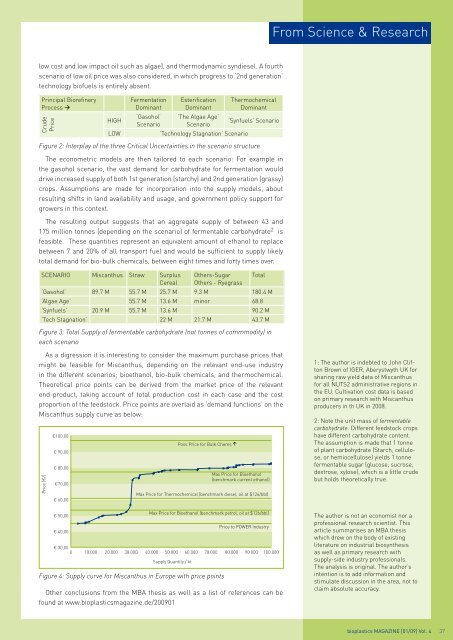bioplasticsMAGAZINE_0901
bioplasticsMAGAZINE_0901
bioplasticsMAGAZINE_0901
Create successful ePaper yourself
Turn your PDF publications into a flip-book with our unique Google optimized e-Paper software.
From Science & Research<br />
low cost and low impact oil such as algae), and thermodynamic syndiesel. A fourth<br />
scenario of low oil price was also considered, in which progress to ‘2nd generation’<br />
technology biofuels is entirely absent.<br />
Principal Biorefinery<br />
Process <br />
Crude<br />
Price<br />
HIGH<br />
LOW<br />
Fermentation<br />
Dominant<br />
‘Gasohol’<br />
Scenario<br />
Esterification<br />
Dominant<br />
‘The Algae Age‘<br />
Scenario<br />
‘Technology Stagnation’ Scenario<br />
Thermochemical<br />
Dominant<br />
‘Synfuels’ Scenario<br />
Figure 2: Interplay of the three Critical Uncertainties in the scenario structure<br />
The econometric models are then tailored to each scenario: For example in<br />
the gasohol scenario, the vast demand for carbohydrate for fermentation would<br />
drive increased supply of both 1st generation (starchy) and 2nd generation (grassy)<br />
crops. Assumptions are made for incorporation into the supply models, about<br />
resulting shifts in land availability and usage, and government policy support for<br />
growers in this context.<br />
The resulting output suggests that an aggregate supply of between 43 and<br />
175 million tonnes (depending on the scenario) of fermentable carbohydrate 2 is<br />
feasible. These quantities represent an equivalent amount of ethanol to replace<br />
between 7 and 20% of all transport fuel and would be sufficient to supply likely<br />
total demand for bio-bulk chemicals, between eight times and forty times over.<br />
SCENARIO Miscanthus Straw Surplus<br />
Cereal<br />
Others-Sugar<br />
Others - Ryegrass<br />
Total<br />
‘Gasohol’ 89.7 M 55.7 M 25.7 M 9.3 M 180.4 M<br />
‘Algae Age’ 55.7 M 13.6 M minor 68.8<br />
‘Synfuels’ 20.9 M 55.7 M 13.6 M 90.2 M<br />
‘Tech Stagnation’ 22 M 21.7 M 43.7 M<br />
Figure 3: Total Supply of fermentable carbohydrate (not tonnes of commmodity) in<br />
each scenario<br />
As a digression it is interesting to consider the maximum purchase prices that<br />
might be feasible for Miscanthus, depending on the relevant end-use industry<br />
in the different scenarios; bioethanol, bio-bulk chemicals, and thermochemical.<br />
Theoretical price points can be derived from the market price of the relevant<br />
end-product, taking account of total production cost in each case and the cost<br />
proportion of the feedstock. Price points are overlaid as ‘demand functions’ on the<br />
Miscanthus supply curve as below:<br />
Price [€/]<br />
€100,00<br />
€ 90,00<br />
€ 80,00<br />
€70,00<br />
€ 60,00<br />
€ 50,00<br />
€ 40,00<br />
€ 30,00<br />
0 10.000 20.000 30.000 40.000 50.000 60.000 70.000 80.000 90.000 100.000<br />
Supply Quantity / kt<br />
Poss Price for Bulk Chems <br />
Figure 4: Supply curve for Miscanthus in Europe with price points<br />
Max Price for Bioethanol<br />
(benchmark current ethanol)<br />
Max Price for Thermochemical (benchmark diesel, oil at $126/bbl)<br />
Max Price for Bioethanol (benchmark petrol, oil at $126/bbl)<br />
Price to POWER Industry<br />
Other conclusions from the MBA thesis as well as a list of references can be<br />
found at www.bioplasticsmagazine.de/20<strong>0901</strong><br />
1: The author is indebted to John Clifton<br />
Brown of IGER, Aberystwyth UK for<br />
sharing raw yield data of Miscanthus<br />
for all NUTS2 administrative regions in<br />
the EU. Cultivation cost data is based<br />
on primary research with Miscanthus<br />
producers in th UK in 2008.<br />
2: Note the unit mass of fermentable<br />
carbohydrate. Different feedstock crops<br />
have different carbohydrate content.<br />
The assumption is made that 1 tonne<br />
of plant carbohydrate (Starch, cellulose,<br />
or hemiocellulose) yields 1 tonne<br />
fermentable sugar (glucose, sucrose,<br />
dextrose, xylose), which is a little crude<br />
but holds theoretically true.<br />
The author is not an economist nor a<br />
professional research scientist. This<br />
article summarises an MBA thesis<br />
which drew on the body of existing<br />
literature on industrial biosynthesis<br />
as well as primary research with<br />
supply-side industry professionals.<br />
The analysis is original. The author’s<br />
intention is to add information and<br />
stimulate discussion in the area, not to<br />
claim absolute accuracy.<br />
bioplastics MAGAZINE [01/09] Vol. 4 37


















